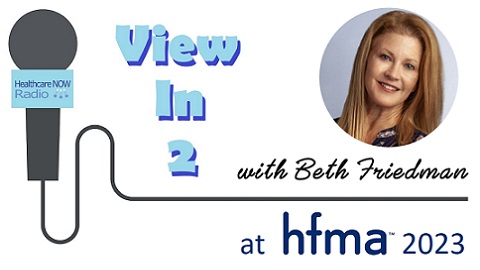 By Beth Friedman, Sr. Partner, FINN Partners
By Beth Friedman, Sr. Partner, FINN Partners
Twitter: @FINNPartners
The HFMA Annual Conference 2023 was recently held at the Gaylord Opryland in Nashville, Tennessee. The event’s online description promised the conference would “embrace the need for change.” And change is certainly required against the backdrop of declining profitability and 0.3% median year-to-date operating margins. Legacy financial and revenue cycle strategies no longer suffice.
However, after spending four action-packed days at HFMA 2023, I’m convinced that finance and revenue cycle leaders have already embraced the need for change and are racing ahead to reap the rewards. Instead of gloom and doom, the event was energizing, inspiring and fun.
Every session was led by industry experts touting advancements in intelligent technologies, automated workflows and data-driven partnerships. While no single speaker or company holds all the keys to margin improvement, each lends a piece to a larger industry puzzle. How do we improve hospital margins and ensure financial sustainability?
To answer that question, I met with several industry executives and speakers to gather their insights. Five of my top takeaways are summarized below, and you can hear some of our actual conversations at Healthcare NOW Radio’s View in Two.
1. Giant Boulders Still Exist
The hospital and health system executives I met during HFMA 2023 share the same four challenges: staffing shortages, payer denials, rising costs and successfully transitioning their organizations to value-based care.
From a staffing perspective, all organizations are implementing new technologies to remove manual, repetitive and laborious tasks from the revenue cycle including AI, ML and RPA. The overarching goal is to increase productivity, do more work with fewer resources and address the ongoing workforce shortage in healthcare. Progress is being made across several revenue cycle functions with productivity and efficiency results already achieved.
Denials remain a challenge. This fact is nothing new for hospitals and health systems. However, there are nascent changes in the volume and types of denials. Payers and health plans are using AI to proactively deny claims based on data analysis and trends. New, preemptive denial management strategies are essential.
Costs continue to rise across healthcare leading to increased pressure for smarter procurement processes and reality checks on acquisitions. And while fee-for-service remains the primary payment model, there is no doubt value-based care reimbursement is ahead. Discussions with attendees focused on how technology, workflow and staff skills must level up to succeed under value-based care models.
2. Automate and Elevate in the Revenue Cycle
Teams that previously balked at change now embrace every opportunity to use digital employees and redeploy revenue cycle staff. One speaker suggested that anything “high volume and high manual” should be automated to fill staff vacancies, accommodate new responsibilities, and move staff to other, more intelligent jobs.
Several speaking sessions shared best practices for how to integrate robotic team members. For example, speakers mentioned giving bots a human first name to ease the tension between legacy personnel and AI. Quality checks should also be conducted on bots just as they are with human employees. Another organization built an innovation governance team specifically for the revenue cycle, with team members submitting automation ideas to receive bonuses.
And there were hundreds of automation vendors across the exhibit hall. One example is MRO Corp, a leading processor of payer requests for medical records. Providers still spend an exorbitant amount of time exchanging data with payers. MRO introduced automation to digitize the fulfillment of payer requests, thereby removing manual tasks and administrative burdens during risk adjustment and other regulatory reviews.
But technology automation alone will not solve healthcare’s financial woes. People must also be upskilled to master new processes. Pat Murphy, General Manager of TruBridge, encouraged revenue cycle professionals to lean into a culture of innovation and learning versus complacency. The talent needed to fuel the work of tomorrow, is much different than the talent and work that we have today. “By elevating workforce skills and capabilities now, revenue cycle leaders ensure teams are prepared for the future,” he said.
3. Thread Patient Experience Throughout the Process
A particularly insightful panel included representatives from Novant Health headquartered in Winston-Salem, Children’s Mercy in Kansas City, and Covenant Health in Knoxville. Speakers in this session reminded attendees to never lose sight of patient experience across the revenue cycle.
From preregistration to final billing and payment, provider organizations can positively reinforce their organization’s brand message with patients, families and their communities. The onus is on the health system to make it easy for patients to stay with the organization. Simple, friendly patient financial experiences help achieve that goal.
Patients also yearn for detailed and personalized financial strategies. One idea was to work with patient financing partners such as ClearBalance HealthCare® to offer convenient, zero-interest financing and help people manage their chronic diseases, such as cancer or diabetes. Other panelist suggestions included:
- Quick, accurate upfront estimates of the patient’s financial responsibility
- Automatic pre-screening for financial assistance at time of registration or scheduling
- Professional interactions that meet patients and families where they are financially
- Brief, but informative, conversations about their bill
- Flexible payment plan options including personalized financing and text to pay
- Nimble processes to accommodate new technologies as they evolve
4. Take Back Your Power with Payers
With denials on the rise, many sessions focused on the relentless dysfunction between payers and providers. Here are three new coping strategies to consider.
Build stronger relationships with employers. Payers appear to possess all the power in healthcare. But this perception isn’t always true. There are situations when employers have more power over payers and should be leveraged to improve reimbursement and even reduce denials. Improve communications with large employers across your region to uncover new payer strategies and then approach payers together, as a united team.
Integrate data for preemptive denial management. By combining consumer data with claims data and real-time clinical data, providers gain new capabilities to establish preemptive denial management programs. These same types of data integration efforts also inform population health initiatives, reduce costs and improve quality outcomes.
Furthermore, effective denials management requires deeper denials intelligence. During his session with SSM Health, Jonathan Wiik, Vice President of Healthcare Insights at FinThrive, reminded attendees the labor crisis is here to stay and RPA represents a greater opportunity to accelerate the work. The session shared that 65% of denials are never reworked, and included four best practices for more preemptive and effective denial management in healthcare:
- Understand exactly which payers deny for specific conditions or treatments. Proactively send payers the exact documents needed up front for these cases.
- Work the right claims at the right time to increase the likelihood of preventing denials from the start.
- Avoid placing data in disparate silos and look at claims from a comprehensive patient history perspective. Each claim is a unique piece of the bigger puzzle.
- Set a goal to automate the whole revenue cycle process—front, middle and back. This may not be possible from the start, but it’s a worthwhile goal that most health systems can achieve.
As stated by Jamie Davis, VP of Revenue Cycle at SSM Health, during the conclusion of Wiik’s session, “You must crawl before you can walk, and you must walk before you run. But don’t be afraid to fail fast and learn from each step.”
Invest in your denials department and connect with clinicians. Every dollar matters in healthcare. And your denials management team are protectors of those dollars. “Members should come from diverse backgrounds and be equipped with advanced analytics to predict where a patient’s condition may worsen, for example, sepsis prediction models,” said Keith Olenik, Chief Information Officer, AHIMA, as reported from a session by Dr. Terrance Govender, VP Medical Affairs, ClinIntell. Claims denial experts equipped with real-time clinical data work collaboratively with clinicians and CDI teams to ensure thorough clinical documentation and data capture, thereby justifying complex medical claims before they are denied.
The need to create a clinical denials prevention framework was reiterated during an informative session by Acclara, a revenue cycle management solutions company. Speakers reminded attendees that clinical denial prevention is never a once-and-done. It is a continuous improvement process that includes four steps: identification and detection, root cause analysis, implementation and execution, and reporting and monitoring. Revenue cycle professionals were encouraged to develop relationships with physicians through a clinical denials advisory committee.
5. Eureka! There Are Still New Ways to Cut Costs in Healthcare
Perhaps one of the most eye-opening conversations I had at HFMA Annual was with David Kirshner, former healthcare CFO and current Managing Partner at LogicSource, a procurement services and technology company focused on indirect, nonclinical expenditures. Kirshner enlightened me on the tremendous amount of money wasted by hospitals and health systems for nonclinical items such as corporate services, marketing, facilities maintenance, construction, logistics, and more.
These expenditures represent up to 20% to 25% of net patient revenue for most organizations. But if nonclinical expenditures are properly managed and purchased, organizations can shave 15% off most procurement costs. Kirshner noted that health systems often spend more money on the exact same goods and services purchased by other industries. This new opportunity to save money is great news for finance executives struggling with tight margins and rising costs.
More Fun Ahead: Next Year in Vegas
Having served in healthcare since 1981, I’m always inspired by the continual rise of women in the ranks. I look ahead to next year’s HFMA Annual Conference in Las Vegas and more wonderful sessions like the women’s leadership panel that included speakers from MedStar, Vanderbilt University Medical Center, BJC Healthcare, and Piedmont Healthcare. Here are some of my favorite clips from the conversation.
- Does the good ole boy network still exist in healthcare? Yes, but it’s not as bad as before.
- Don’t let decisions be made when you’re not in the room. Men make decisions on the golf course.
- When women get ready to do something, they get it done!
- Enlist the support of a sponsor, ask questions, and be part of groups in your organization.
As Heather Dunn, Vice President and Chief Revenue Cycle Officer of Vanderbilt University Medical Center concluded, “There is a big, open space to do innovative, fun things in the revenue cycle.” It’s time to have fun!

